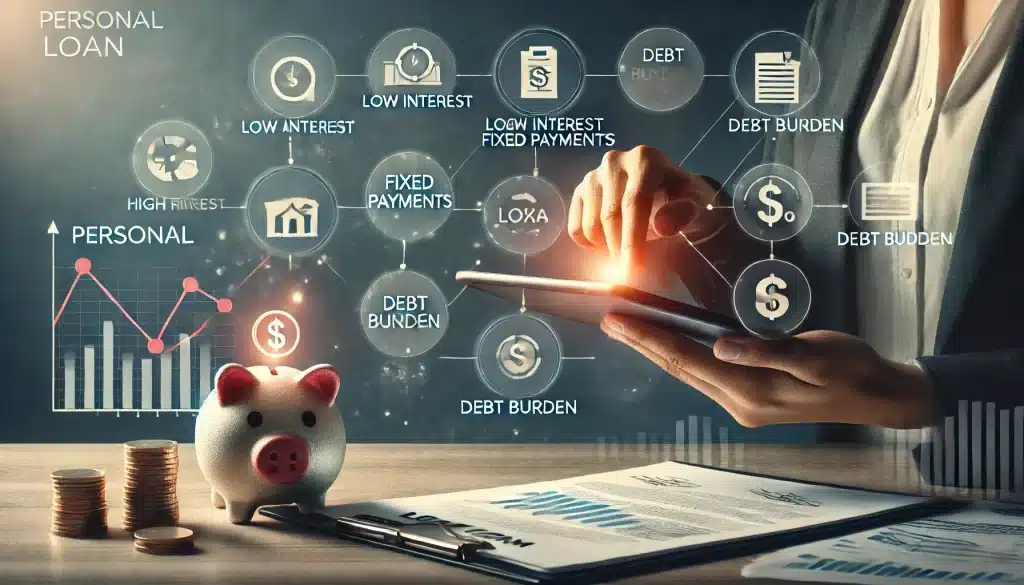Personal loans in the US have become a popular financial tool, offering flexibility and a range of benefits for various needs. As individuals navigate through unexpected expenses, debt consolidation, or investments, understanding these loans is crucial. Known for their accessibility, personal loans are often chosen for their relatively simple application process.
The essence of personal loans lies in their versatility and the conditions under which they are offered. They are typically unsecured, meaning you don’t have to offer collateral, making them inherently appealing. Whether you need to cover medical expenses or finance a home renovation, grasping the specifics of personal loans can lead to well-informed financial decisions.
Types of personal loans available

There are two main types of personal loans: secured and unsecured. Secured loans require collateral, such as a car or home, which reduces the lender’s risk and often results in lower interest rates and higher loan amounts. However, the borrower risks losing their asset if they fail to make payments. Unsecured loans, on the other hand, do not require collateral but typically come with higher interest rates because they pose a greater risk to lenders.
Additionally, personal loans can have either fixed or variable interest rates. Fixed-rate loans maintain the same interest rate throughout the repayment period, providing predictable monthly payments, which can help with budgeting. Variable-rate loans, however, fluctuate based on market conditions, meaning the interest rate could decrease or increase over time, affecting monthly payments. Another common category of personal loans is debt consolidation loans, designed to combine multiple debts into a single loan with a potentially lower interest rate. This can simplify payments and reduce the overall cost of high-interest debt, such as credit card balances.
Benefits of personal loans
One of the main advantages of personal loans is flexibility—borrowers can use the funds for various purposes, from covering emergency expenses to funding major life events. Unlike some types of loans that are tied to specific purchases, such as auto loans or mortgages, personal loans offer greater freedom in how the borrowed money is spent. This makes them particularly useful for unexpected financial situations where immediate funding is needed. Additionally, personal loans generally come with lower interest rates than credit cards, making them an attractive option for refinancing high-interest debt.
Since personal loans have fixed monthly payments, borrowers can better manage their budgets and avoid the risk of accumulating revolving debt, as often happens with credit cards. Moreover, making on-time payments on a personal loan can contribute to credit score improvement, helping borrowers build a stronger financial profile for future loan applications. For those looking for a reliable financial partner to explore personal loan options, Genial Crédito offers comprehensive information and assistance in finding the best loan solutions based on individual financial needs.
Risks and downsides of personal loans
While personal loans provide many benefits, they also come with potential risks. One of the primary concerns is the high-interest rates for borrowers with low credit scores. Individuals with poor credit history may face significantly higher rates, increasing the overall cost of the loan and making repayment more challenging. Another significant risk is debt accumulation, which can occur if borrowers take out a loan without a clear repayment plan. If monthly payments are missed or delayed, it can lead to credit score damage, making it harder to qualify for favorable loan terms in the future.
Additionally, some personal loans come with prepayment penalties, meaning borrowers may have to pay extra fees if they decide to pay off the loan earlier than the agreed-upon term. According to Consumer Financial Protection Bureau (CFPB), it is crucial to carefully review loan terms, fees, and repayment conditions before committing to any borrowing agreement.
How to qualify for a personal loan in the U.S.
To qualify for a personal loan, lenders evaluate several factors, including credit score, income stability, and debt-to-income ratio. A higher credit score increases the chances of approval and secures better interest rates, while lower scores may result in higher costs or even loan denial.
Lenders also assess the borrower’s ability to repay the loan based on their debt-to-income (DTI) ratio, which measures monthly debt payments against income. Many lenders prefer a DTI ratio below 40%, as it indicates responsible financial management. Borrowers can apply for personal loans through banks, credit unions, or online lenders, each offering different terms, processing times, and approval criteria.
Tips for choosing the right personal loan
Choosing the right personal loan requires careful research and comparison. Interest rates and fees should be examined closely, as hidden costs can significantly affect the total repayment amount. Borrowers should also read the terms and conditions carefully to ensure there are no surprises, such as prepayment penalties or excessive fees.
Additionally, it is essential to avoid predatory lenders who offer loans with misleading terms or extremely high-interest rates. Reputable lenders will provide clear loan agreements and transparent terms. Before finalizing a loan, borrowers should calculate their monthly repayment ability to ensure they can comfortably meet their obligations without financial strain.

